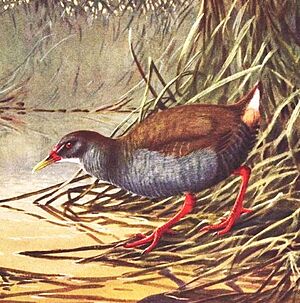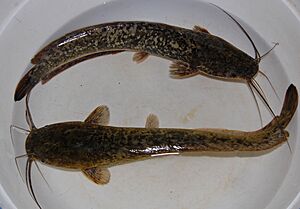Zapata rail facts for kids
Quick facts for kids Zapata rail |
|
|---|---|
 |
|
| Illustration by Allan Brooks | |
| Conservation status | |
| Scientific classification | |
| Genus: |
Mustelirallus
|
| Species: |
cerverai
|
 |
|
| Green shows known range | |
The Zapata rail (Mustelirallus cerverai) is a medium-sized, dark bird from the rail family. It has brown feathers on its back and grey-blue feathers underneath. Its bill is yellow with a red base, and it has red eyes and legs. This bird's short wings mean it can barely fly. It lives only in the wetlands of the Zapata Peninsula in southern Cuba. Its only known nest was found in tall sawgrass plants. We don't know much about what it eats or how it raises its young.
This bird was found by a Spanish zoologist named Fermín Zanón Cervera in March 1927. He found it in the Zapata Swamp in Cuba. The Zapata Swamp is also home to another unique bird, the Zapata wren. The Zapata sparrow is also named after this area. The Zapata rail is in danger because its home is shrinking. It also faces threats from animals that are not native to the area, like mammals and catfish. Because of these dangers, the Zapata rail is listed as critically endangered. Future threats include tourism and climate change.
Contents
Discovering the Zapata Rail
The Zapata rail was officially named by American scientists Thomas Barbour and James Lee Peters in 1927. They thought it was so special that it needed its own group, called Cyanolimnas. The name cerverai honors Fermín Zanón Cervera, who found the bird. Cervera was a Spanish soldier who stayed in Cuba after the Spanish–American War. He became a professional naturalist, studying nature.
Thomas Barbour had visited Cuba with Cervera before. When Barbour heard about strange birds in the Zapata area, he sent Cervera to explore. Cervera finally found the rail near a small village called Santo Tomás. This village is remembered in the bird's Spanish name, "Gallinuela de Santo Tomás." Cervera also discovered the Zapata wren and the Zapata sparrow. Today, a new nature center in the Ciénaga de Zapata National Park is named after him.
The rail family has over 150 different types of birds. The Zapata rail belongs to the group Mustelirallus. It is thought to be related to birds in the Pardirallus group. Birds in these two groups have long bills. Most of them have plain feathers and a red spot at the base of their bill.
What the Zapata Rail Looks Like
This is a medium-sized, dark bird, about 29 cm (11.4 in) long. Its back is olive-brown, and its head and belly are slate-grey. It has some white stripes on its lower belly. The feathers under its tail are white. Its eyes, legs, and feet are red. The bill is yellow with a red base. The tail feathers are thin, and its wings are very short and round.
Male and female Zapata rails look similar. Young birds are duller in color and have olive-colored feet and bills. Baby rails, like all rail chicks, are covered in blackish down. The Zapata rail's call is described as a bouncing cutucutu-cutucutu-cutucutu. It also makes a loud kuvk kuck sound. However, these calls might actually belong to another bird, the spotted rail.
There are no other birds in Cuba that look like the Zapata rail. The spotted rail, which lives in the same area, is about the same size. But it has many white spots and stripes. The Zapata rail's feathers look like a mix between the Colombian crake and the plumbeous rail. But these other birds live on the mainlands of Central and South America.
Where the Zapata Rail Lives and Its Home
This rail lives only in Cuba. It is found in the northern part of the Zapata Swamp. This swamp covers about 4500 km2 (1740 mi2). The Zapata wren and a type of Zapata sparrow also live only here. The Zapata rail likes to live in flooded areas with tall plants. These plants are usually 1.5–2.0 m (60–80 in) high. Its home includes tangled, bush-covered swamp areas and low trees. It prefers places near higher ground. Common plants in the swamp are wax myrtle, willow trees, sawgrass, and narrow leaf cattail.
The Zapata rail used to live in more places. Scientists have found old bones of this bird in Havana, Pinar del Río, and the Isla de la Juventud. The bones found on Isla de la Juventud are from smaller birds than the ones alive today. But there aren't enough bones to know if they were truly different groups of birds.
Behaviour and Life Cycle

The Zapata rail usually builds its nest in Cladium jamaicensis sawgrass. It builds the nest above the water on a raised clump of grass. They usually breed around September. They might also breed in December and January. An American ornithologist named James Bond found a nest with three white eggs. The nest was 60 cm (2 ft) above the water in sawgrass. We don't know much else about how they raise their young. Rails usually have one partner for life. Their chicks are born ready to move around and are cared for by their parents.
The bird prefers to find food in sawgrass. We don't know exactly what it eats. But most marsh rails eat both invertebrates (like insects) and plants. These birds might spread out during the rainy season. Then they return to areas that are always flooded during the dry months.
Like other rails, this bird is hard to see because it moves through the sawgrass. It might crouch down to avoid being seen. But it is not usually very shy. If it gets scared, it might run a short distance. Then it stops with its tail up, showing its white undertail feathers. Even though its wings are short, the Zapata rail might not be completely unable to fly. Its body structure suggests it cannot fly well. But James Bond said he saw one flutter about ten feet across a canal.
Protecting the Zapata Rail

Birds that live on islands are very easily lost. This is because they often lose the ability to fly well. This makes them easy targets for new animals brought to the island. Since the year 1600, fifteen types of rails have disappeared forever. More than 30 types are currently in danger.
The Zapata rail was easy to find in the Santo Tomás area until 1931. Then, it wasn't seen again until the 1970s. At that time, birds were found 65 km (40 mi) away at Laguna del Tesoro. The few sightings since then suggest that there are still very few of them. After no official sightings for twenty years, a survey in 1998 found the birds in two new places in the Zapata Swamp. Ten rails were seen at Peralta, and seven at Hato de Jicarita. Based on this, scientists thought there were about 70–90 rails in that area. As of 2016, the only sighting for several years was in November 2014.
The Zapata rail lives in only one area, which is about 1,000 km2 (400 mi2). Its small population is estimated to be between 250 and 1,000 birds. This number is decreasing. In the past, cutting grass for roof thatch destroyed many nesting places. Now, burning the plants during the dry season continues to destroy their home. Animals like small Asian mongooses and rats, which were brought to the island, also eat the rails. More recently, African sharptooth catfish have been found to eat many rail chicks.
The Zapata rail was listed as endangered until 2011. Then, its status was changed to critically endangered. This change was suggested because we don't know much about its calls. This means the number of rails might be even lower than we think.
Two places where the rails live are protected areas. These are the Corral de Santo Tomás Faunal Refuge and the Laguna del Tesoro nature tourism area. Scientists have been studying the areas where the rails live. They have suggested ways to protect them, like controlling fires during the dry season.
Future Dangers
Cuba plans to bring more tourists, including to the Zapata area. Changes in United States policy mean its citizens can now visit Cuba. In the future, this could increase the effects of ecotourism. This might harm the wetland. But there are ways to reduce the impact of many tourists.
In the long term, the Zapata Swamp itself could be in danger. Rising sea levels due to global warming could fill the wetland with saltwater. This would harm the plants and animals. By 2100, the Zapata Swamp area could shrink by one-fifth. Warmer ocean temperatures from climate change could also cause stronger hurricanes and droughts. One expert warned that plants knocked down by hurricanes could dry out and become fuel for more damaging fires.
See also
 In Spanish: Gallinuela de Santo Tomás para niños
In Spanish: Gallinuela de Santo Tomás para niños



